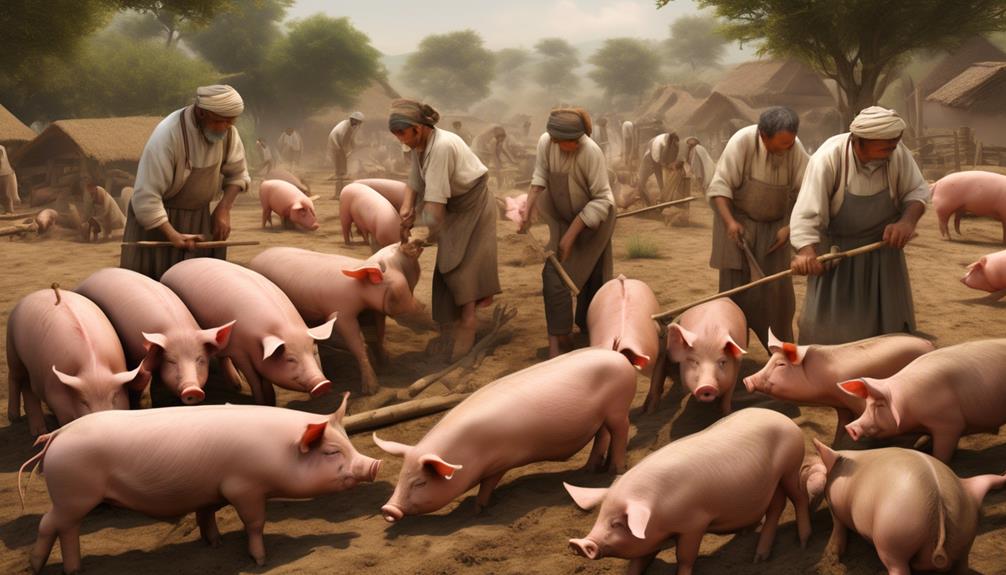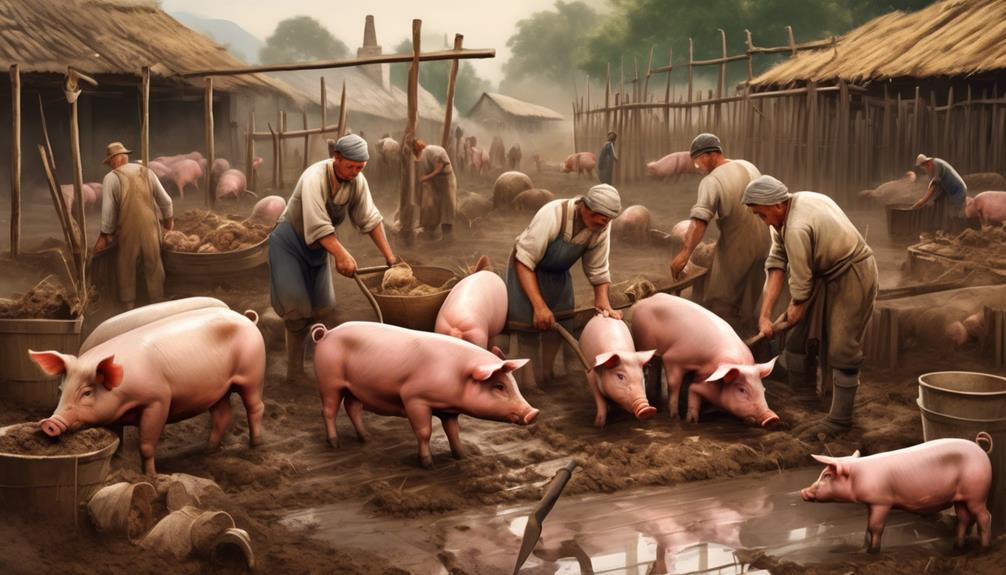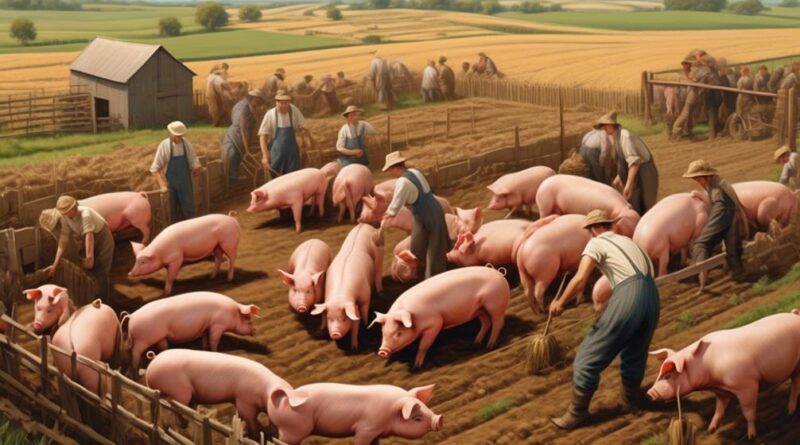7 Best Insights Into Pigs' Role in Early Agriculture
As you explore the annals of early agriculture, you'll find that pigs played a pivotal role, akin to the roots of a sturdy tree nourishing the soil. The partnership between humans and pigs in the cultivation of the land goes beyond mere sustenance, encompassing a symbiotic relationship that shaped the very foundation of farming practices.
From their domestication to their contribution to soil fertility and food production, the insights into pigs' role in early agriculture offer a fascinating glimpse into the interconnectedness of humans and animals in shaping the agricultural landscape.
Understanding these insights not only sheds light on the past but also provides valuable lessons for sustainable farming practices today.
Early Domestication of Pigs
The domestication of pigs began over 10,000 years ago, marking a significant milestone in early agriculture. At this time, humans transitioned from a nomadic hunting and gathering lifestyle to settled farming communities. Pigs played a crucial role in this agricultural revolution, providing a readily available source of meat, leather, and other valuable resources.
Early societies recognized the benefits of keeping pigs, as they were relatively easy to care for and could thrive on a varied diet. As a result, humans began selectively breeding wild boars for desirable traits such as docility and increased meat production. This process of pig domestication led to the development of distinct breeds that were better suited to the needs of early farmers.
The agricultural revolution brought about by pig domestication had far-reaching effects on human civilization. With a more stable and sustainable food source, communities were able to grow and prosper. Pigs also contributed to the development of agricultural practices such as crop rotation, as their manure proved to be an invaluable fertilizer for crops.
Importance of Pigs in Farming
Pigs' pivotal role in early agriculture is evident in their contributions to farming, including their provision of meat, leather, and valuable resources. Their importance in farming goes beyond these obvious outputs. Pigs' natural behavior of rooting and grazing makes them excellent at managing the land and clearing fields. Additionally, pig manure serves as a valuable fertilizer, enhancing soil fertility and promoting crop growth.
Here are some key points to consider:
- Pigs' Natural Behavior:
- Pigs are natural foragers and grazers, making them effective at clearing land and managing vegetation. Their innate ability to root and dig helps in preparing the soil for planting, reducing the need for manual labor and machinery.
- Pigs' tendency to consume a wide variety of food sources, including grass, plants, and insects, allows them to thrive in diverse agricultural settings, contributing to the sustainable management of ecosystems.
The utilization of pig manure as fertilizer:
- Pig manure is rich in nutrients such as nitrogen, phosphorus, and potassium, essential for plant growth. Its application as organic fertilizer improves soil structure, increases microbial activity, and enhances overall soil health.
- The use of pig manure as a natural fertilizer reduces the reliance on synthetic inputs, promoting sustainable and environmentally friendly agricultural practices.
Pigs as Livestock in Ancient Times

During ancient times, pigs served as essential livestock for early human societies, providing a versatile source of sustenance and valuable resources. Early pig domestication was a significant advancement in agriculture, as it allowed for a more controlled and sustainable means of obtaining food and materials.
Pig farming techniques in ancient times varied across different cultures and regions, but they generally involved keeping pigs in enclosed areas to prevent them from wandering off and to facilitate breeding and feeding.
Early pig domestication involved selectively breeding pigs for desirable traits such as size, temperament, and meat quality. This process led to the development of domesticated pig breeds that were better suited for providing meat, leather, and other valuable resources. As a result, pigs became an integral part of agricultural societies, providing a reliable source of protein and materials.
Pig farming techniques in ancient times also included the use of feeding and breeding strategies to ensure the health and productivity of pig herds. Ancient farmers would have employed various methods to feed pigs, including foraging in forests and supplying supplementary food such as grains and kitchen scraps. Additionally, they would have utilized breeding techniques to improve the genetic traits of their pig herds over time.
Pig Breeds Used for Agriculture
Selecting appropriate pig breeds for agriculture is crucial for ensuring optimal productivity and resource utilization on farms. When considering pig breeds for agricultural purposes, it's important to take into account various factors such as adaptability to specific environments, growth rate, and feed conversion efficiency.
Here are some insights into the pig breeds commonly used for agriculture:
- Heritage Breeds
- Known for their hardiness and ability to forage, making them well-suited for free-range farming practices.
- Often preferred for their high-quality meat and unique flavors, contributing to diverse agricultural products.
- Commercial Breeds
- Bred for rapid growth and efficient feed conversion, maximizing meat production for commercial purposes.
- Emphasize traits such as leanness and muscle development, aligning with modern consumer preferences for pork products.
Pig breeding techniques play a significant role in determining the suitability of different pig breeds for agriculture. Selective breeding, artificial insemination, and genetic selection are some of the methods utilized to enhance desirable traits in pigs, ultimately influencing their impact on agricultural practices. By strategically breeding pigs to exhibit traits such as disease resistance, reproductive efficiency, and overall meat quality, farmers can optimize their farming operations and contribute to sustainable agricultural practices.
Understanding the impact of pig breeds on agricultural practices is essential for farmers seeking to maximize production efficiency while maintaining the welfare of their livestock. By carefully selecting and breeding pig breeds, farmers can positively influence the dynamics of early agriculture, ensuring the continued relevance of pigs in modern farming systems.
Role of Pigs in Soil Fertility
How can pigs contribute to enhancing soil fertility on agricultural lands?
Pigs play a significant role in soil fertility through their natural behaviors and waste products. Their rooting and foraging activities help to aerate the soil, break up compacted areas, and promote the decomposition of organic matter. As a result, the soil's structure is improved, allowing for better water infiltration and root growth.
Additionally, pigs contribute to nutrient recycling by redistributing organic matter and nutrients from one area to another. Their manure is rich in nitrogen, phosphorus, and potassium, which are essential elements for plant growth. When properly managed, pig manure can be used as an organic fertilizer, replenishing the soil with valuable nutrients and enhancing its overall fertility.
In soil management, pigs are often integrated into sustainable farming systems to optimize nutrient cycling. By allowing pigs to roam in certain areas, their natural behavior helps to distribute organic matter and nutrients more evenly across the land. This reduces the need for synthetic fertilizers and minimizes the risk of nutrient imbalances in the soil.
Moreover, pig manure can be composted and used to enrich the soil, promoting healthier and more productive crops. Overall, the role of pigs in soil fertility highlights their contribution to sustainable agricultural practices and underscores the importance of incorporating these animals into holistic farming strategies.
Pigs' Contribution to Food Production
Pigs play a pivotal role in food production, providing a valuable source of protein and other essential nutrients for human consumption. When it comes to pig breeding, their rapid reproduction cycle makes them an efficient source of meat, with sows giving birth to multiple piglets at a time, ensuring a consistent supply of pork. Additionally, pigs are highly adaptable and can thrive in various environments, making them an accessible source of food in diverse regions.
In terms of nutritional value, pork is a rich source of high-quality protein, essential vitamins, and minerals. Pork contains important nutrients such as thiamine, riboflavin, niacin, vitamin B6, phosphorus, and protein, all of which are vital for the body's growth, development, and overall health. Moreover, pork is also a good source of iron, a nutrient that's essential for maintaining energy levels and supporting the immune system. This makes pork a valuable addition to the diet, especially in areas where access to a diverse range of foods is limited.
With their efficient breeding capabilities and high nutritional value, pigs have become an indispensable part of food production, helping to meet the dietary needs of communities across the globe. Whether it's through traditional farming methods or modern agricultural practices, pigs continue to play a crucial role in ensuring a sustainable supply of protein-rich food for human consumption.
Pigs in Ancient Agricultural Practices

In ancient agricultural practices, early farmers relied on pigs to cultivate and fertilize the land, laying the foundation for sustainable food production. Pigs played a crucial role in ancient diets, providing a significant source of protein and essential nutrients for early civilizations. Their ability to convert food scraps and forage into high-quality meat made them a valuable asset for food security. Additionally, pigs were integral to the fertility of the land through their manure. The nutrient-rich pig manure served as an effective natural fertilizer, enhancing soil quality and promoting better crop growth.
Pigs were adept at foraging and could thrive on a varied diet, including agricultural by-products and natural vegetation. This made them well-suited to diverse agricultural settings, where they could efficiently convert a range of feed sources into valuable meat. Their adaptability meant that they could be raised in various environments, contributing to their widespread presence in early farming practices across different regions.
The use of pig manure as a fertilizer was a sustainable agricultural practice that improved soil fertility and supported robust crop yields. Early farmers recognized the value of harnessing pig manure to enhance the productivity of their land, thereby establishing a sustainable agricultural cycle. This utilization of natural resources highlights the ingenuity of ancient agricultural practices, where pigs played a multifaceted role in supporting food production and land cultivation.
Cultural Significance of Pigs in Early Farming
The pivotal role of pigs in ancient agricultural practices extends beyond their contribution to food production and land cultivation, encompassing their cultural significance in early farming communities. Pigs held a prominent place in religious rituals, being revered as symbols of fertility and abundance. In many ancient societies, pigs were associated with deities and were sacrificed to appease the gods and ensure a prosperous harvest.
Pigs weren't only a source of sustenance but also played a profound role in shaping the cultural and spiritual fabric of early farming communities. Their presence in religious rituals and their role as companions highlights the deep-rooted significance of pigs in the cultural and social dynamics of ancient agricultural societies. Understanding these cultural aspects provides valuable insights into the interconnectedness of humans and pigs in early farming practices.
Additionally, pigs were often seen as companions to humans, providing not only sustenance but also emotional support and companionship. Their intelligence and sociable nature made them valuable members of early farming communities, fostering a bond that extended beyond mere utility.
Frequently Asked Questions
What Were the Specific Challenges Faced by Early Farmers in Domesticating Pigs?
When domesticating pigs, early farmers faced challenges like adapting to pigs' wild nature and finding effective domestication techniques. It required patience, trial and error, and understanding the pigs' behaviors to successfully domesticate them.
How Did the Role of Pigs in Early Agriculture Vary Across Different Regions and Cultures?
Cultural variations in early agriculture shaped the role of pigs differently across regions. Despite similar agricultural challenges, pigs were utilized diversely, reflecting the unique practices and needs of different cultures in utilizing these animals for farming.
What Impact Did the Use of Pigs in Ancient Farming Have on the Overall Environment and Ecosystem?
Using pigs in ancient farming had a significant impact on biodiversity and ecological implications. Their foraging behavior and waste management affected the overall environment and ecosystem, shaping the landscape and contributing to both positive and negative consequences.
Were There Any Religious or Spiritual Beliefs Associated With Pigs in Early Agricultural Societies?
Did pigs hold religious beliefs or cultural significance in early agricultural societies? They were central to taboo practices and spiritual rituals, embodying both sacred and practical elements in rituals and beliefs of many ancient cultures.
How Did the Use of Pigs in Early Agriculture Contribute to the Development of Trade and Commerce?
Using pigs in trade had a significant economic impact in early agriculture. They provided valuable resources like meat, leather, and fat, which were essential for commerce and contributed to the development of trade routes and networks.
Conclusion
So, now you have a better understanding of the vital role that pigs played in early agriculture.
From their domestication to their contribution to soil fertility and food production, pigs have been a crucial part of farming for centuries.
Their cultural significance and versatility as livestock make them an important part of our agricultural history.
